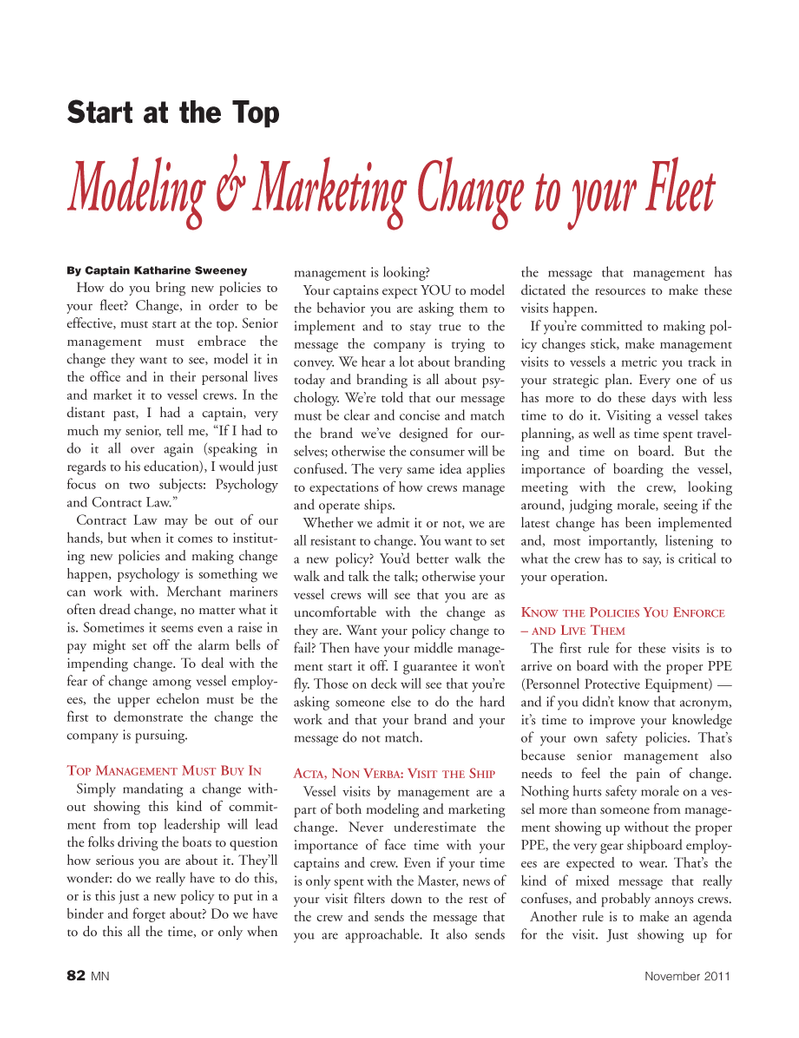
Page 82: of Marine News Magazine (November 2011)
Workboat Annual
Read this page in Pdf, Flash or Html5 edition of November 2011 Marine News Magazine
82MNNovember 2011By Captain Katharine SweeneyHow do you bring new policies to your fleet? Change, in order to be effective, must start at the top. Senior management must embrace thechange they want to see, model it inthe office and in their personal lives and market it to vessel crews. In the distant past, I had a captain, very much my senior, tell me, ?If I had to do it all over again (speaking in regards to his education), I would just focus on two subjects: Psychology and Contract Law.? Contract Law may be out of ourhands, but when it comes to institut-ing new policies and making change happen, psychology is something we can work with. Merchant mariners often dread change, no matter what it is. Sometimes it seems even a raise in pay might set off the alarm bells ofimpending change. To deal with the fear of change among vessel employ- ees, the upper echelon must be thefirst to demonstrate the change thecompany is pursuing. TOPMANAGEMENT MUSTBUYINSimply mandating a change with- out showing this kind of commit- ment from top leadership will lead the folks driving the boats to questionhow serious you are about it. They?ll wonder: do we really have to do this, or is this just a new policy to put in a binder and forget about? Do we have to do this all the time, or only whenmanagement is looking?Your captains expect YOU to model the behavior you are asking them to implement and to stay true to the message the company is trying to convey. We hear a lot about branding today and branding is all about psy-chology. We?re told that our message must be clear and concise and matchthe brand we?ve designed for our- selves; otherwise the consumer will be confused. The very same idea applies to expectations of how crews manage and operate ships. Whether we admit it or not, we are all resistant to change. You want to set a new policy? You?d better walk the walk and talk the talk; otherwise your vessel crews will see that you are as uncomfortable with the change as they are. Want your policy change to fail? Then have your middle manage- ment start it off. I guarantee it won?t fly. Those on deck will see that you?re asking someone else to do the hard work and that your brand and your message do not match. ACTA , NONVERBA: VISITTHE SHIPVessel visits by management are a part of both modeling and marketing change. Never underestimate the importance of face time with your captains and crew. Even if your time is only spent with the Master, news of your visit filters down to the rest of the crew and sends the message that you are approachable. It also sends the message that management hasdictated the resources to make these visits happen.If you?re committed to making pol- icy changes stick, make managementvisits to vessels a metric you track in your strategic plan. Every one of us has more to do these days with less time to do it. Visiting a vessel takes planning, as well as time spent travel- ing and time on board. But the importance of boarding the vessel, meeting with the crew, looking around, judging morale, seeing if the latest change has been implementedand, most importantly, listening to what the crew has to say, is critical to your operation. KNOWTHE POLICIESYOUENFORCE ? ANDLIVETHEMThe first rule for these visits is to arrive on board with the proper PPE (Personnel Protective Equipment) ? and if you didn?t know that acronym, it?s time to improve your knowledge of your own safety policies. That?s because senior management alsoneeds to feel the pain of change.Nothing hurts safety morale on a ves- sel more than someone from manage- ment showing up without the proper PPE, the very gear shipboard employ- ees are expected to wear. That?s the kind of mixed message that really confuses, and probably annoys crews. Another rule is to make an agenda for the visit. Just showing up for Start at the Top Modeling & Marketing Change to your Fleet MN#11 (82-97):MN 2011 Layouts 11/3/2011 9:37 AM Page 82

 81
81

 83
83
